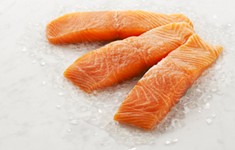
The industry plans to grow to 210,000 tons of annual production by 2020, a growth of around 4 percent per year, Scott Lansburgh, chief executive of the Scottish Salmon Producers Organization, told SeafoodSource.
“We have worked with the Scottish government to ensure the sustainable development of production over recent years, and the early results are demonstrated in encouraging [export] figures,” Lansburgh said.
Around 158,000 tons of Scottish farmed salmon was produced in 2011, and 2012 was another strong year “comparable with the last two years,” according to Lansburgh (the Scottish government has not yet released 2012 data). Exports of Scottish salmon have spiked to record levels for the second consecutive year, growing by 22 percent to 95,638 tons in 2011.
For the first time, North America took over as the main export market for farmed Scottish salmon, rising 35 percent in 2011, while European imports remained the same. Emerging markets have realized the most striking increases in farmed salmon imports. For example, the Far East’s imports of Scottish salmon jumped 894 percent to 6,799 tons in 2011 and Middle East imports rose 17 percent to 1,562 tons.
“The huge popularity surge from emerging markets in the Far East demonstrates the untapped opportunities for continued growth in Scottish salmon exports,” Lansburgh said.
Scottish salmon producers plan to further grow international exports over the next two years with the help of a new program from the SSPA, Seafood Scotland, and Scottish Development International. The three organizations have signed a sponsorship deal with the World Association of Chefs Societies, in which Scottish salmon and langoustine will be used in a series of culinary competitions between 2012 and 2014, Lansburgh said.
While the Scottish farmed salmon industry has gone through recent consolidation and supply issues, Lansburgh does not foresee the problems limiting future supply and demand. For example, The Scottish Salmon Company recently had challenges with Amoebic Gill Disease and associated biological issues, which led to the loss of around 2,000 tons of salmon that would have been harvested in the second half of 2013.
However, the Scottish salmon industry overall has improved the health of its fish and is conforming with stringent animal welfare standards, according to Lansburgh. About 90 percent of Scottish farmed salmon production will be represented in the Royal Society for the Prevention of Cruelty to Animals’ standards program by 2014.





